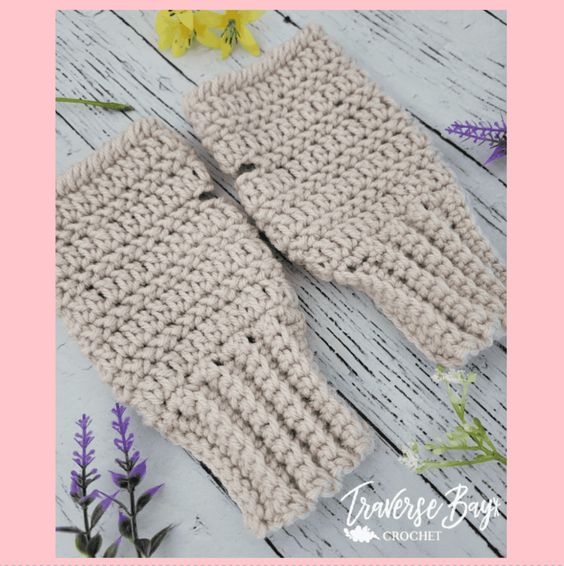Crochet Herringbone Fingerless Gloves
Crochet Herringbone Fingerless Gloves are a trendy and practical accessory for chilly days. They combine style and warmth, making them a perfect choice for anyone who loves adding a touch of coziness to their outfits. The herringbone stitch gives these gloves a unique texture and a modern look that stands out from traditional crochet patterns. They are not only stylish but also functional, as they keep your hands warm while allowing your fingers to remain free for tasks like texting or typing. Whether you're a seasoned crocheter looking for a new project or a beginner eager to try something fun and fashionable, these fingerless gloves are a delightful choice that you'll enjoy making and wearing.

Materials:
- Size H, 5.00 mm hook
- Medium worsted weight yarn (size 4)
- Tapestry needle
Abbreviations:
ch- chain
st(s)- stitch(es)
hk- hook
sc- single crochet
BLO- back loop only
sl st- slip stitch
dc- double crochet
hhdc- herringbone half double crochet
Special stitches:
Herringbone half double crochet (HHDC)
The Herringbone Half Double Crochet (HHDC) is a variation of the traditional half double crochet (HDC) stitch, with a slight twist that creates a slanted, textured look resembling a herringbone pattern.
Yarn Over (YO): As with a normal HDC, you start by yarning over the hook.
Insert the Hook: Insert your hook into the next stitch (just like for a regular HDC).
Pull Through Stitch: Yarn over again and pull through the stitch. Now you should have three loops on your hook.
Pull Through First Loop: Here’s where the difference lies! Instead of yarning over again right away, first pull the first loop through the second loop on your hook. This slants the stitch and gives it the herringbone effect.
Complete the Stitch: Yarn over again and pull through the remaining two loops on your hook. You’ve now completed one herringbone half double crochet stitch!
Crab stitch (reverse single crochet)
The crochet crab stitch, also known as the reverse single crochet, is a decorative edging stitch that is worked in the opposite direction of standard crochet stitches. Instead of moving from right to left (for right-handed crocheters), the crab stitch is worked from left to right, creating a twisted, rope-like texture.
Insert Hook in the Previous Stitch (to the Right):
- Instead of inserting the hook into the next stitch on your left, insert it into the stitch immediately to the right. If you are right-handed, this means you are crocheting backwards. For left-handed crocheters, work from right to left instead.
Pattern:
Cuff:
Ch 11
Row 1: Sc in the 2nd ch from the hk and each ch to end, turn (10).
Rows 2-18: Ch 1, sc in the BLO in each st to end, turn (10).
Fold cuff in half and sl st together the back loop only of on side and the front loop only of the other.
Body:
Continue to sc 26 sts around the top of the cuff (they will be close together), sl st to join (26).
Round 1: Ch 2, dc in each st around, sl st to join (26).
Round 2: Ch 2, hddc in each st around, sl st to join (26).
Rounds 3-4: Repeat round 1-2.
Round 5: Ch 2, dc 12, ch 4, sk next 4 sts, dc last 10 sts, sl st to join (22).
Round 6, Ch 2, hhdc next 12 sts, hhdc in each of the 4 chains you made in the last row, hhdc last 10 sts, sl st to join (26).
Round 7: Ch 2, dc in each st around, sl st to join (26).
Round 8: Ch 2, hhdc in each st around, sl st to join (26).
Round 9: Ch 2, dc in each st around, sl st to join (26).
Round 10: Ch 1, crab stitch in each st around, fasten off on last st.
Weave in ends.
Repeat with other fingerless mitten.